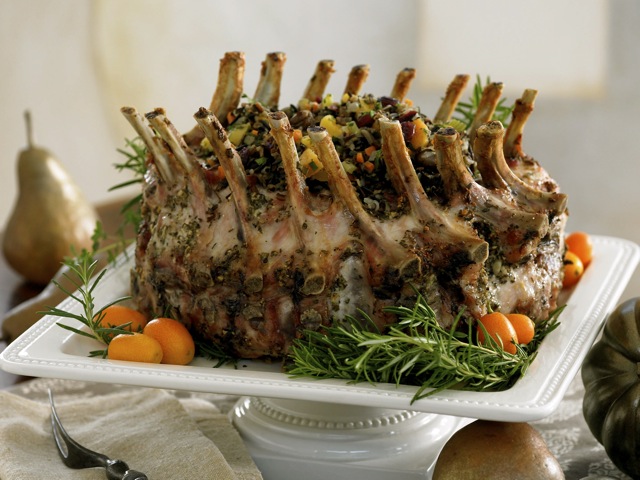Top | The Christmas Table
Garlic and Herb Rubbed Crown Roast of Pork
(recipe, Diane Morgan)

primary-image, l
Introduction
A crown roast of pork makes a spectacular presentation on a holiday buffet or dining table. Traditionally, the center of the roast is filled with either a bread or rice stuffing. I prefer to roast the pork without stuffing for the same reason I don’t stuff a turkey: the meat will be overcooked by the time the stuffing is cooked through.
I also recommend you brine the pork. When I was developing this recipe, I first roasted the pork without brining it and was sorely disappointed in the blandness of the meat. Brining improves the texture of the pork, making it tender and juicy throughout, plus the flavors of the herbs and spices in the brine penetrate to the center of the roast. Plan ahead because you will need to special-order the roast from a butcher. Let the butcher know how many guests you will be serving to determine what size crown roast you will need. Plan on serving 1 or 2 chops per person.
Ingredients
Roast
- 2 turkey-sized plastic oven bags
- 1 crown roast of pork (8 to 10 pounds, about 14 to 22 ribs)
Brine
- ½ cup Diamond Crystal kosher salt
- ½ cup sugar
- 3 fresh sage leaves
- 3 sprigs fresh thyme
- 1 bay leaf
- 4 whole cloves
- 1 tsp. juniper berries, crushed
- 1 tsp. allspice berries, crushed
- ½ tsp. peppercorns, crushed
- 4 cups cool water
- 4 cups ice water
Paste
- 4 large cloves garlic, minced
- 1 Tbsp. finely chopped fresh sage
- 1 Tbsp. finely chopped fresh thyme
- ¼ cup extra-virgin olive oil
- 2 tsp. kosher or sea salt
- ½ tsp. freshly ground pepper
Steps
- You need to prepare the juniper brine and start brining the crown roast 24 hours before you plan to start roasting it. Have ready a bowl large enough to hold the roast. Place 1 plastic oven bag inside the second bag to create a double thickness; then place these bags, open wide, in the bowl. Fold back the top one-third of the bags, making a collar (this helps to keep the top of the bag open). Remove the pork from its wrapping. Place the pork inside the double-thick bags, with the rib bones pointing upward, and unfold the collar.
- To make the brine, combine the salt, sugar, sage, thyme, bay leaf, cloves, juniper and allspice berries, peppercorns, and cool water in a 3-quart saucepan. Bring to a boil over high heat, stirring to dissolve the salt and sugar. Boil for 3 minutes. Remove from the heat. Add the ice water, stir, and set aside to cool completely.
- Pour the cooled brine over the pork. Draw up the top of the inner bag, squeezing out as much air as possible, and secure it closed with a twist tie. Do the same for the outer bag. The pork should be completely submerged in the brine. Place the pork in the refrigerator to brine for 24 hours.
- To roast the pork, remove the pork from the refrigerator 1½ hours before you plan to roast it. Set the bowl aside, and place the brined pork, still in its bags, in the sink. Open and discard the bags, brine, and any herbs or spices remaining on the pork. Rinse the pork under cold water and pat thoroughly dry with paper towels. Transfer the pork to a shallow roasting pan.
- To make the herb and garlic paste, combine the garlic, sage, thyme, olive oil, salt, and pepper in a small bowl. Rub the paste generously over all the pork, including inside the cavity and between the bones. Set the pork, rib bones down (upside down), in the roasting pan. Set aside to marinate at room temperature for up to 1 hour.
- Thirty minutes before you plan to roast the pork, position a rack in the lower third of the oven. Preheat the oven to 450 degrees.
- Roast the pork for 15 minutes. Lower the oven temperature to 325 degres and continue roasting the meat for another hour. Check the temperature of the pork. The pork is done when an instant-read thermometer inserted into the thickest part not touching bone registers 145 to 150 degrees. (A 9-pound roast should take about 1¾ hours to reach 145 degrees.) Keep in mind that the temperature of the meat will increase another 5 to 10 degrees as the meat rests before carving. Let the meat rest, tented with foil, for 20 minutes to allow the juices to set.
- To serve, place the pork on a warmed platter so the rib bones face upward. Fill the cavity with the wild rice and scatter the remaining wild rice around the base of the roast. Alternatively, serve the wild rice or the bread stuffing on the side, or place the roast on a bed of herbs and fill the cavity with a bouquet of the same herbs. To carve the roast, use a carving fork to steady the roast and cut between the rib bones to separate the chops. Serve 1 or 2 chops per person.

